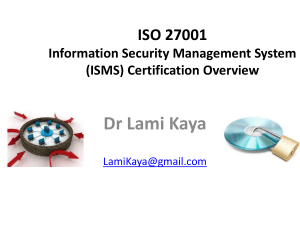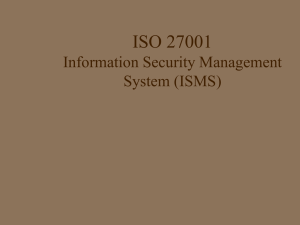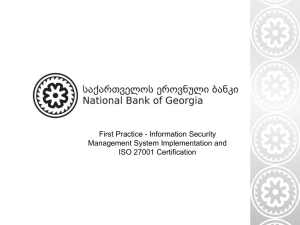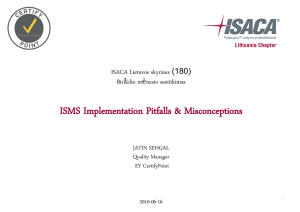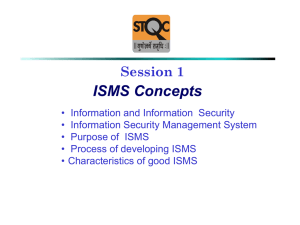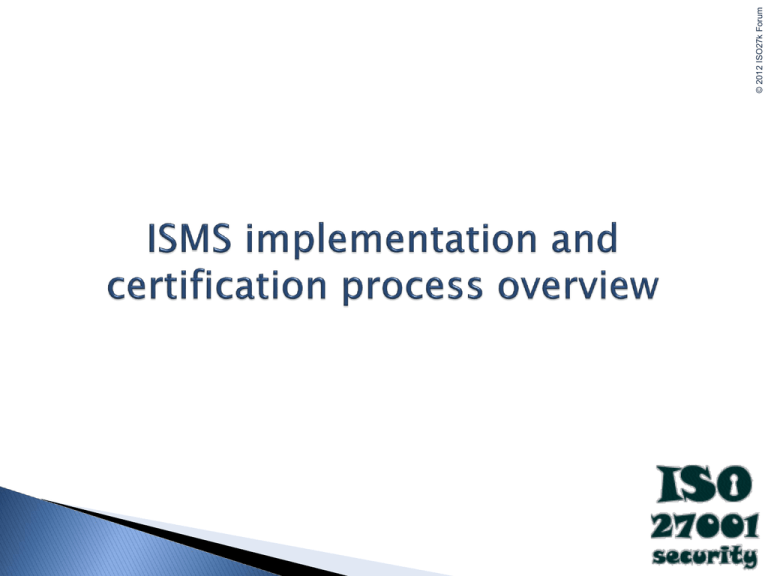
© 2012 ISO27k Forum
© 2012 ISO27k Forum
ISO27001 - Roadmap
© 2012 ISO27k Forum
ISO27001
ISO27001 formally specifies how to establish an Information
Security Management System (ISMS).
The adoption of an ISMS is a strategic decision.
The design and implementation of an organization’s ISMS is
influenced by its business and security objectives, its security
risks and control requirements, the processes employed and the
size and structure of the organization: a simple situation
requires a simple ISMS.
The ISMS will evolve systematically in response to changing
risks.
Compliance with ISO27001 can be formally assessed and
certified. A certified ISMS builds confidence in the
organization’s approach to information security management
among stakeholders.
© 2012 ISO27k Forum
ISO27002
ISO27002 is a “Code of Practice” recommending a large
number of information security controls.
Control objectives throughout the standard are generic,
high-level statements of business requirements for
securing or protecting information assets.
The numerous information security controls
recommended by the standard are meant to be
implemented in the context of an ISMS, in order to
address risks and satisfy applicable control objectives
systematically.
Compliance with ISO27002 implies that the
organization has adopted a comprehensive, good
practice approach to securing information.
© 2012 ISO27k Forum
Management
support is vital
Management should actively support information
security by giving clear direction (e.g. policies),
demonstrating the organization’s commitment, plus
explicitly assigning information security
responsibilities to suitable people.
Management should approve the information security
policy, allocate resources, assign security roles and
co-ordinate and review the implementation of security
across the organization.
Overt management support makes information
security more effective throughout the organization,
not least by aligning it with business and strategic
objectives.
© 2012 ISO27k Forum
Define ISMS
scope
Management should define the scope of the ISMS in
terms of the nature of the business, the organization,
its location, information assets and technologies.
Any exclusions from the ISMS scope should be
justified and documented.
◦
◦
Areas outside the ISMS are inherently less trustworthy, hence
additional security controls may be needed for any business
processes passing information across the boundary.
De-scoping usually reduces the business benefits of the ISMS.
If commonplace controls are deemed not applicable,
this should be justified and documented in the
Statement of Applicability (SOA)
The certification auditors will check the
documentation.
© 2012 ISO27k Forum
Inventory information
assets
An inventory of all important information assets
should be developed and maintained, recording
details such as:
◦ Type of asset;
◦ Format (i.e. software, physical/printed, services,
people, intangibles)
◦ Location;
◦ Backup information;
◦ License information;
◦ Business value (e.g. what business processes
depend on it?).
© 2012 ISO27k Forum
Assess information
security risks
Risk assessments should identify, quantify, and prioritize
information security risks against defined criteria for risk
acceptance and objectives relevant to the organization.
The results should guide and determine the appropriate
management action and priorities for managing information
security risks and for implementing controls selected to protect
against these risks.
Assessing risks and selecting controls may need to be
performed repeatedly across different parts of the organization
and information systems, and to respond to changes.
The process should systematically estimate the magnitude of
risks (risk analysis) and compare risks against risk criteria to
determine their significance (risk evaluation).
The information security risk assessment should have a clearly
defined scope and complement risk assessments in other
aspects of the business, where appropriate.
© 2012 ISO27k Forum
SOA
The Statement of Applicability (SOA) is a key ISMS
document listing the organization’s information
security control objectives and controls.
The SOA is derived from the results of the risk
assessment, where:
◦ Risk treatments have been selected;
◦ All relevant legal and regulatory requirements have
been identified;
◦ Contractual obligations are fully understood;
◦ A review the organization’s own business needs and
requirements has been carried out.
© 2012 ISO27k Forum
Prepare Risk
Treatment Plan
The organisation should formulate a risk treatment
plan (RTP) identifying the appropriate management
actions, resources, responsibilities and priorities for
dealing with its information security risks.
The RTP should be set within the context of the
organization's information security policy and should
clearly identify the approach to risk and the criteria for
accepting risk.
The RTP is the key document that links all four phases
of the PDCA cycle for the ISMS (next 2 slides).
© 2012 ISO27k Forum
The "Plan-Do-Check-Act" (PDCA)
model applies at different levels
throughout the ISMS (cycles within
cycles).
The same approach is used for
quality management in ISO9000.
The diagram illustrates how an ISMS
takes as input the information
security requirements and
expectations and through the PDCA
cycle produces managed information
security outcomes that satisfy those
requirements and expectations.
© 2012 ISO27k Forum
Plan (establish the ISMS)
◦ Establish ISMS policy, objectives, processes and procedures relevant to
managing risk and improving information security to deliver results in
accordance with an organization’s overall policies and objectives.
Do (implement and operate the ISMS)
◦ Implement and operate the ISMS policy, controls, processes and procedures.
Check (monitor and review the ISMS)
◦ Assess and, where applicable, measure process performance against ISMS
policy, objectives and practical experience and report the results to
management for review.
Act (maintain and improve the ISMS)
◦ Take corrective and preventive actions, based on the results of the internal
ISMS audit and management review or other relevant information, to achieve
continual improvement of the ISMS.
© 2012 ISO27k Forum
Implement the
programme
Implement the Risk Treatment Plan in order to achieve
the identified control objectives, which includes
consideration of funding and allocation of roles and
responsibilities.
Implement controls selected during establishing the
ISMS to meet the control objectives.
Define how to measure the effectiveness of controls to
allows managers and staff to determine how well
controls achieve planned control objectives.
Implement security training and awareness
programmes.
© 2012 ISO27k Forum
Information Security
Management
System (ISMS)
It is important to be able to demonstrate the
relationship from the selected controls back to the
risk assessment and risk treatment process, and
subsequently back to the ISMS policy and objectives.
ISMS documentation should include:
Documented statements of the ISMS policy and objectives;
The scope of the ISMS;
Procedures and other controls in support of the ISMS;
A description of the risk assessment methodology;
A risk assessment report and Risk Treatment Plan (RTP);
Procedures for effective planning, operation and control of
the information security processes, describing how to
measure the effectiveness of controls;
◦ Various records specifically required by the standard;
◦ The Statement of Applicability (SOA).
◦
◦
◦
◦
◦
◦
© 2012 ISO27k Forum
Compliance
Review
Corrective actions
Management must review the organization’s ISMS at
least once a year to ensure its continuing suitability,
adequacy and effectiveness.
They must assess opportunities for improvement and
the need for changes to the ISMS, including the
information security policy and information security
objectives.
The results of these reviews must be clearly
documented and maintained (“records”).
Reviews are part of the ‘Check’ phase of the PDCA
cycle: any corrective actions arising must be managed
accordingly.
© 2012 ISO27k Forum
Pre-Certification
Assessment
Prior to certification, the organization should carry out
a comprehensive review of the ISMS and SOA.
The organization will need to demonstrate compliance
with both the full PDCA cycle and clause 8 of
ISO27001, the requirement for continual
improvement.
Certification auditors will seek evidence (in the form of
records of processes such as risk assessments,
management reviews, incident reports, corrective
actions etc.) that the ISMS is operating and continually
improving.
The ISMS therefore needs a while to settle down,
operate normally and generate the records after it has
been implemented.
© 2012 ISO27k Forum
Certification
Audit
Certification involves the organization’s ISMS
being assessed for compliance with ISO27001.
The certification body needs to gain assurance
that the organization’s information security risk
assessment properly reflects its business
activities for the full scope of the ISMS.
The assessors will check that the organization
has properly analysed and treated its information
security risks and continues managing its
information security risks systematically.
A certificate of compliance from an accredited
certification body has credibility with other
organizations
© 2012 ISO27k Forum
Continual
Improvement
The organization shall continually improve the
effectiveness of the ISMS through the use of:
◦
◦
◦
◦
◦
◦
The information security policy;
Information security objectives;
Audit results;
Analysis of monitored events;
Corrective and preventive actions;
Management review.
© 2012 ISO27k Forum
ISO/IEC 27001:2005. Information Technology - Security
ISO/IEC 27002:2005. Information Technology - Security
Alan Calder & Steve Watkins (2012). IT Governance: an
Techniques – Information Security Management Systems –
Requirements. Known as ISO 27001.
Techniques - Code of Practice for Information Security
Management. Known as ISO 27002.
International Guide to Data Security and ISO27001/ISO27002.
5th edition. Kogan Page Publishing.
© 2012 ISO27k Forum
Retrac Consulting provides
consultancy advice on the provision
of an Information Assurance regime
for an organisation to protect their
information assets, data and
systems on which the data is stored,
processed and transmitted. This is
achieved through the assessment of
threats to information systems, an
analysis of the vulnerabilities that
might be exploited by those threats,
an understanding of the impact of
identified risks, and the application of
technical and non-technical
countermeasures to reduce those
risks to an acceptable level for the
business.
Marty Carter MBCS CITP
Managing Director
Retrac Consulting Ltd
Tel: +44 (0) 7920 074261
Fax: +44 (0) 1242 292003
Email: information@retracconsulting.co.uk
Web: www.retrac-consulting.co.uk
© 2012 ISO27k Forum
This work is copyright © 2010, ISO27k Forum, some
rights reserved. It is licensed under the Creative
Commons Attribution-Noncommercial-Share Alike 3.0
License. You are welcome to reproduce, circulate, use
and create derivative works from this provided that:
(a) It is not sold or incorporated into a commercial
product;
(b) It is properly attributed to the ISO27k Forum at
www.ISO27001security.com; and
(c) If shared, derivative works are shared under the same
terms as this.


